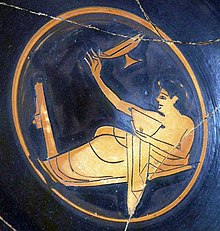This article should specify the language of its non-English content, using {{lang}}, {{transliteration}} for transliterated languages, and {{IPA}} for phonetic transcriptions, with an appropriate ISO 639 code. Wikipedia's multilingual support templates may also be used. (July 2021) |

Kottabos (Ancient Greek: κότταβος) was a game of skill played at Ancient Greek and Etruscan symposia (drinking parties), especially in the 6th and 5th centuries BC. It involved flinging wine-lees (sediment) at a target in the middle of the room.[1] The winner would receive a prize (κοττάβιον or "kottabion"), comprising cakes, sweetmeats, or kisses.[citation needed]
Ancient writers, including Dionysius Chalcus, Alcaeus, Anacreon, Pindar, Bacchylides, Aeschylus, Sophocles, Euripides, Aristophanes, and Antiphanes, make frequent and familiar allusion to the practice;[2] and it is depicted on contemporaneous red-figure vases. References to the practice by the writers of the Roman and Alexandrian periods show that the fashion had died out. In Latin literature, it is almost entirely unknown.
Dexterity was required to succeed in the game, and unusual ability was rated as highly as corresponding excellence in throwing the javelin. Kottabos was customary, and, at least in Sicily, special circular buildings were established, so the players might easily be arranged around the target, and follow each other in rapid succession. Like all games in which the element of chance found a place, it was regarded as more or less ominous of the future success of the players, especially in matters of love – and the excitement was sometimes further augmented by some object of value being staked on the event. The stake in the game was often a servant[clarification needed] attending the symposium with the players.[3]